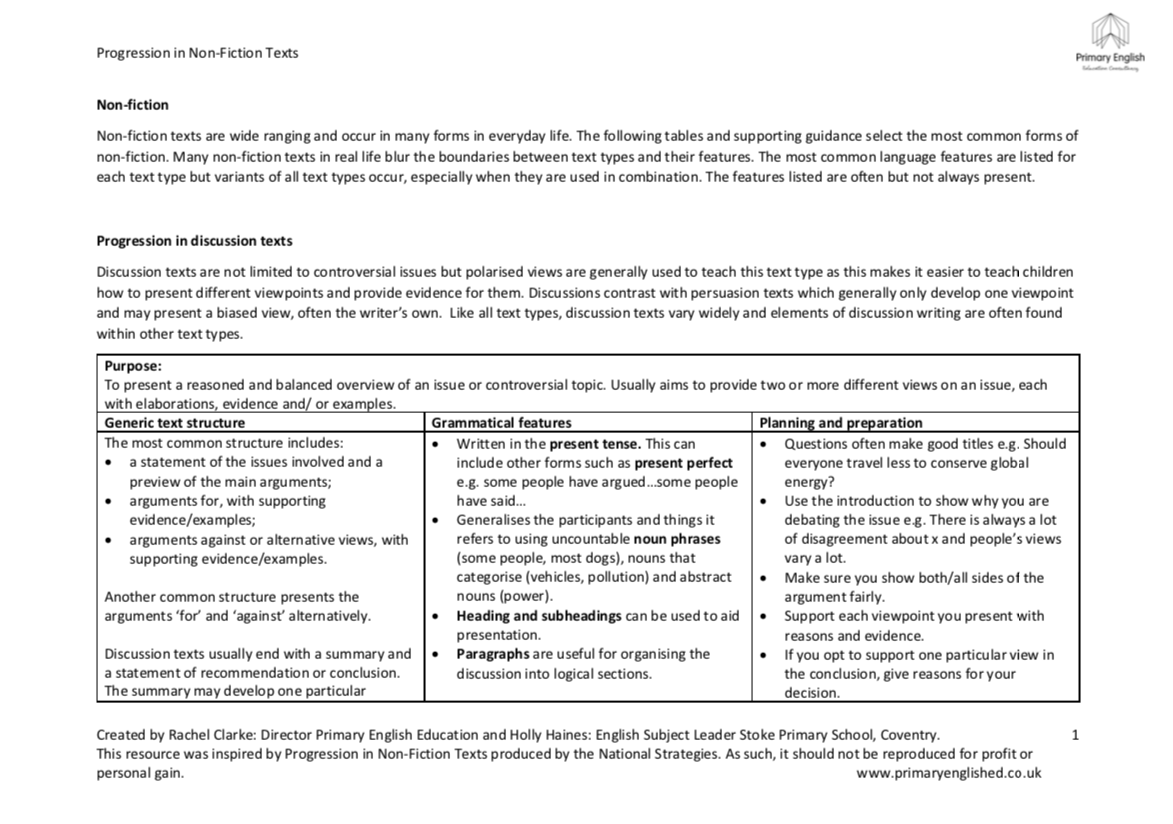Progression in Non-Fiction Texts
In a rare turn of events, I have rediscovered my long-neglected blog and decided to share my thoughts with those of you even mildly interested in hearing them.
I’ve been busy. I mean really busy. I’ve been working in schools, writing teaching materials and all too often chasing my tail as I try to catch up with myself. I’m not complaining. Having a lot to do is the dream position for those of us who are self-employed. And I’ve loved all the opportunities that have come my way since taking my online sabbatical. But it’s time to get back on the web and start sharing the fruits of my labours. Because I’ve made a thing. And I think it’s a thing a few of you might like. In fact, I think it’s a thing that might prove rather useful in your school.
On scrutinising the writing in a school recently, it became apparent that children from Year 1 to Year 6 were writing approximately a gazillion diaries and letters in their English lessons and that said first-person accounts looked somewhat similar regardless of the age and capabilities of the children. What also became apparent was that teachers were offering opportunities to write non-chronological reports, instructions, explanation texts and so on, but these texts didn’t always seem to suit the grammatical objectives being taught or include instructions for children to include key grammatical features when perhaps they could be used to good effect in a specific form of writing.
This is a pattern I’ve seen in other schools and it points to a couple of issues. One is the prevalence of the genre forms taught through the National Strategies as a first port of call for writing contexts. The other, is an unsurprising knowledge deficit of where grammatical features exist naturally within different forms of writing (this is not critique; it's empathy).
So firstly, genre. I’ve read other bloggers opinions on these over the last couple of years and my opinion is a slightly nuanced version of some of these. The 2014 National Curriculum does not require children to produce texts that fulfil the structural requirements of the genres taught through the National Strategies approach. It does though, stipulate that children write for an audience and intended purpose. My position is that children still need to write to inform, persuade, explain etc. but they do not need to produce texts that tick off structural (text level) features as happened under the NS model. Let’s be straight about this, I’m not dissing the National Strategies. The National Strategies always recognised that in reality written texts blur the lines between different genres but in the execution of this, I think it is fair to say, the teaching of writing became focussed on the structural aspects of each of the genre taught in KS1 and KS2.
The 2014 National Curriculum emphasises grammar. Grammar has its own statutory appendix in the curriculum document (signalling its significance) and we know from the TAFs that the application of grammatical forms is a significant aspect of the assessment process. What we need children to do is write texts that demonstrate their understanding of grammar whilst being written for an intended audience and purpose. If you know which grammar is used purposefully and authentically to write for these different purposes and audiences all seems fairly straightforward. But let’s be honest about this, how many of us know this? How many of us have a degree in English language? Most secondary English specialists have a degree in English literature rather than language, so without jumping to conclusions secondary colleagues, I’m guessing you guys have to do a bit of thinking about the authentic use of grammar too.
So, my thing. It’s a document that supports the teaching of the grammar outlined in the National Curriculum so that it’s used authentically to meet the purpose and audience of a piece of writing. And here’s the thing with my thing; it’s an adaptation of an old National Strategies document but repurposed to meet the needs of the 2014 National Curriculum.
Because of this, you will find it organised into broad genre descriptors, but I’ve reduced the emphasis on text level objectives. I’ve included some planning tips to support the plan, draft, edit, proofread structure of the National Curriculum and most importantly, I’ve matched the National Curriculum grammar objectives to each writing purpose so that you can see where and how they can be taught authentically. I’ve also compiled a list of different forms of writing you might expect to find under each genre heading and I’ve also created a table of grammatical features you might expect to see when explaining, persuading, instructing etc, in each year group.
Sound interesting? Well I hope so. It’s been used in a few schools I know and has been received very positively. And what have I called this thing? Well, Progression in Non-fiction Texts. You’re most welcome to download it, use it and share it (if you find it useful).
If you've enjoyed this post, you may be interested in Progression in fiction texts.

